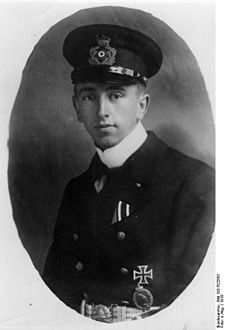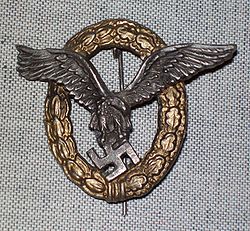Theo Osterkamp
| Theo Osterkamp | |
|---|---|
| Narození | 15. dubna 1892 Düren |
| Úmrtí | 2. ledna 1975 (ve věku 82 let) Baden-Baden |
| Povolání | letecké eso |
| Ocenění | Pour le Mérite Rytířský kříž Železného kříže |
| Některá data mohou pocházet z datové položky. | |
Theodor Osterkamp (15. dubna 1892, Düren, Německé císařství – 2. ledna 1975, Baden-Baden, Německá spolková republika) byl stíhacím esem nasazeným v první i druhé světové válce, během níž působil u německé Luftwaffe. Za první světové války, během níž dosáhl 32 vítězných sestřelů, létal po boku stíhacího esa Oswalda Boelckeho a byl dobrým přítelem „Rudého Barona“ Manfreda von Richthofen. Za druhé sv. války vedl během bitvy o Británii stíhací eskadru Jagdgeschwader 51, v níž se mu povedlo dosáhnout šesti sestřelů a stal se tak jedním z mála pilotů, kterému se podařilo dosáhnout sestřelu protivníka v obou světových válkách.
Vyznamenání
 Pour le Mérite (02.09.1918)
Pour le Mérite (02.09.1918) Rytířský kříž Železného kříže (22.08.1940)
Rytířský kříž Železného kříže (22.08.1940) Rytířský kříž, I. třída
Rytířský kříž, I. třída Rytířský kříž, II. třída
Rytířský kříž, II. třída Rytířský kříž, spona k Železnému kříži 1914, I. třídy
Rytířský kříž, spona k Železnému kříži 1914, I. třídy Rytířský kříž, spona k Železnému kříži 1914, II. třídy
Rytířský kříž, spona k Železnému kříži 1914, II. třídy Královský hohenzollernský domácí řád , rytířský kříž s meči
Královský hohenzollernský domácí řád , rytířský kříž s meči Kříž cti
Kříž cti Baltský kříž
Baltský křížSpolečný odznak pro piloty a pozorovatele[1]
Odkazy
Literatura
- CAMPBELL, Christopher. Aces and aircraft of World War I. Poole, Dorset: Blandford Press, 1981. Dostupné online. ISBN 9780713709544. S. 129-130. (anglicky)
- BEKKER, Cajus. The Luftwaffe War Diaries: The German Air Force in World War II. Cambridge, Massachusetts: Da Capo Press, 1994. Dostupné online. ISBN 9780306806049. S. 169. (anglicky)
Reference
Externí odkazy
 Obrázky, zvuky či videa k tématu Theo Osterkamp na Wikimedia Commons
Obrázky, zvuky či videa k tématu Theo Osterkamp na Wikimedia Commons - (anglicky) Aces of the Luftwaffe - životopis Thea Osterkampa Archivováno 2. 12. 2008 na Wayback Machine.
- (německy) Stručný Osterkampův životopis
- (anglicky) Freie Jagd Details[nedostupný zdroj]
- Válka.cz, generálporučík Theodor Osterkamp
Média použitá na této stránce
(c) Bundesarchiv, Bild 183-R22853 / CC-BY-SA 3.0
Marineflieger Theo Osterkamp (Porträt) 6637-18
Abgebildete Personen:
- Osterkamp, Theodor: Generalmajor, Ritterkreuz (RK), Luftwaffe, Orden Pour le mérite, Deutschland (GND 124745822)
Ribbon bar: Prussian Royal House Order of Hohenzollern with Swords on War-Ribbon.
(Königlicher Hausorden von Hohenzollern mit Schwertern am Kriegsband)
Autor: Scargill, Licence: CC BY-SA 3.0
The Pilot/Observer Badge (German: Flugzeugführer- und Beobachterabzeichen) was a World War II German military decoration awarded to Luftwaffe service personnel who had already been awarded the Pilot's Badge and Observer Badge. It was instituted on 26 March 1936 by the Commander in Chief of the Luftwaffe Hermann Göring. It was worn on the lower part of the left breast pocket of the service tunic, underneath the Iron Cross 1st Class if awarded. It was to replace the older 1933 Aircrew Badge. The badge was originally manufactured in bronze, and later zinc. The badge can be distinguished from the Pilot's Badge by the gold wreath; the Pilot's Badge had a silver wreath. There was also a cloth version of the badge which used embroidered bullion for the officer's version and cotton for the NCO's version. The presentation case was dark blue, with a blue satin top liner and a blue velvet bottom liner on the inside.
Ribbon bar: Knight's Cross of the Iron Cross (Third Reich) – version.
Ribbon bar: Iron Cross 2nd Class (1914) with reiteration 1939 (Third Reich).
Ribbon bar: Iron Cross 1st Class (1914) with reiteration 1939 (Third Reich).
Ribbon bar: Iron Cross - 1st Class (1813)-1914-1918 (Prussia).
Ribbon bar: Iron Cross 2nd Class (1813)-1914-1918 (Prussia) and Golden Military Merit Cross 1864-1918 (Prussia).
Ribbon bar: "Honour Cross of the World War 1914/1918" (German Reich, 3 classes), here - for front-line veterans with swords.
Ribbon bar: Prussian Pour le Mérite (Blue Max)











